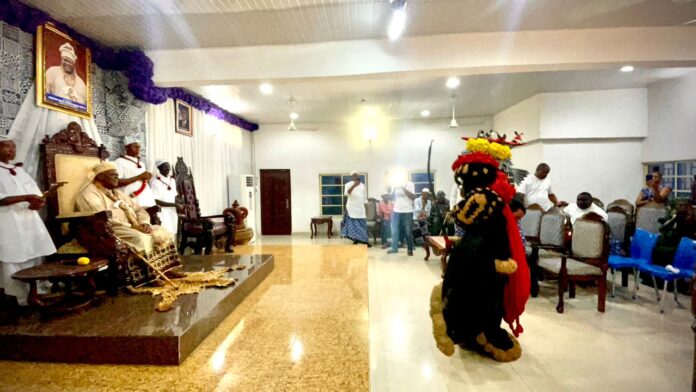© Holyns Hogan , 2023
Again, I am prompted to re-do this post because the ignorance that its “original copy” sought to check is yet fully checked.
Reference to the subject, the Efik’s pọpular ekọmbi song-“Ayuto”, often fully rendered wrongly by [most] singers as “Ayuto, Ayuto! Ayuto sariñkpe! Eda mmọñ eyet eyen eda ndom eyet (instead of “eda mmọñ eyet eyen EDA NDOM EBOK”) is one that really needs to be corrected for the negative linguistic signal or evil (extinction) omen it potends against Efik oral literature/language heritage in future. Note that emphasis is on the use of EDA NDOM EYET in the song.
Though it may naturally sound strange to most Efik people that merely see the song as [a] pleasure- giver, it is deeper in meaning to those who truly know/appreciate it for its ideological, spiritual, cosmic, mythytical and literary depths. The song, in this wise, is one which, like every other Ekọmbi ITIAT NTOKON (original ekọmbi) song, was mainly designed by Efik ancestors for specially adorned maiden dancers that led Ndem worship processions in the ancients.
The colours mainly found in their costume were AFIA, UTO, AWA MMỌÑ IBỌÑ and MMỌÑ IBỌÑ, while their facial and body make-up was mainly made of NDOM decor- of NSIBIDI pictograph/script that only initiates understood. The song, amongst others, was mainly used by believers during the traditional dedication service for Efik children named ASANDIA (Asa emi emande/amanade ke usen uwak ndia/eyen emi esiode enyiñ edian Anansa/emi amanade k’ọfiọñ uwak idọk emi udia odude uwak ekese ke obio), ASARI (isuñ nduñọde /mkpọ uto idem) and Ekpenyọñ (abasi) etc., to whom UTO was always wari (as captured in the eulogy-“Ekpenyọñ, Ekpenyọñ Odusu! Esim Usen Ndem Enye Awari Uto”).
The song literarily translates to- Ayuto (figurative reference to the yellow/yellowish yoke in Ndemism) that symbolizes wealth, prosperity and beauty in Ndem’s theophanic form (Mkpe-as Efik religion, ruling power and government), for whom the waters of the earth (mmọñ) and the chalk (ndom) are not only sacredly used as physical cleansers and adorners, but nurturers of heritage to posterity or eternity (mkpọñ).
Also note instructively that Efik eyet eyen Ndom, edi ke uban Ekpe (Ekpe initiation/symbolically has to do with Ekpe fraternity tradition). It is also for Ndem worship decoration and/or ritual purpọse. It means evil if negatively applied, particularly where a father, family head or family openly curses and disown a child, kin or family member as severest penalty for a serious taboo that either draws wrath of the gods or tannishes family image. Certainly, except, it is otherwise used in this latter sense to mean evil (as rarely experienced), it contextually remains as presented.
Further note that UYET NDOM is different from UFIỌÑỌ NDOM (suggestive of Ndom rubing/skin application for medicinal, cosmetic, fashion/theatre make-up purpose(s). Truth is that Ndom helps to cure heat rashes, smoothen, adorn or appease the skin when afflicted or in nkuhọ (fattening room seclusion/after child birth). Further, is UTUAK NDOM, a figurative reference to one of the mkpoto rituals performed to honour nwan nkuhọ/ndo with free will cash or gift donations while sitting on Efik traditional marriage dais.
Meanwhile, for easy reference, Ndom is the Efik name for chalk. It is traditionally believed by ndemites (Ndem worshippers) to be a natural endowment that does not only [etymologically] derive (though amongst other claims) from “Ndem corruption”… to infer Ndem sacred decor or worship symbol, but one that is mostly found in “iso ndem” or coastal/wetland areas that open to Ndem’s underwater cove/cave or Ekuk, equally defined as a hut for Efik chief priest/ndem shrine.
Nkañ/ukañ, on the other hand, is chacoal/coal derived as the product of totally burnt firewood/coal mining. While Ndom is considered “sacred”, ornamental, curative and appeasing, and is mostly used traditionally and/or religiously for positiive reasons, nkañ is contextually its direct/exact opposite. In effect, even if it is noted that nkañ/ukañ has its positive use as combustible enyine/ cooking fuel, or, is use by some masquerades to convey or symbolize the personality or image of the spirit of the dead (Ekpo- again, a direct opposite of Ndem, despite being equally seen as a form of worship or belief system in Efik), it doesn’t negate the fact that nkañ, in the attitude of obubit/ubit, mostly symbolizes evil in Efik cosmology and mythology as it is in other global places with similar belief or culture.










